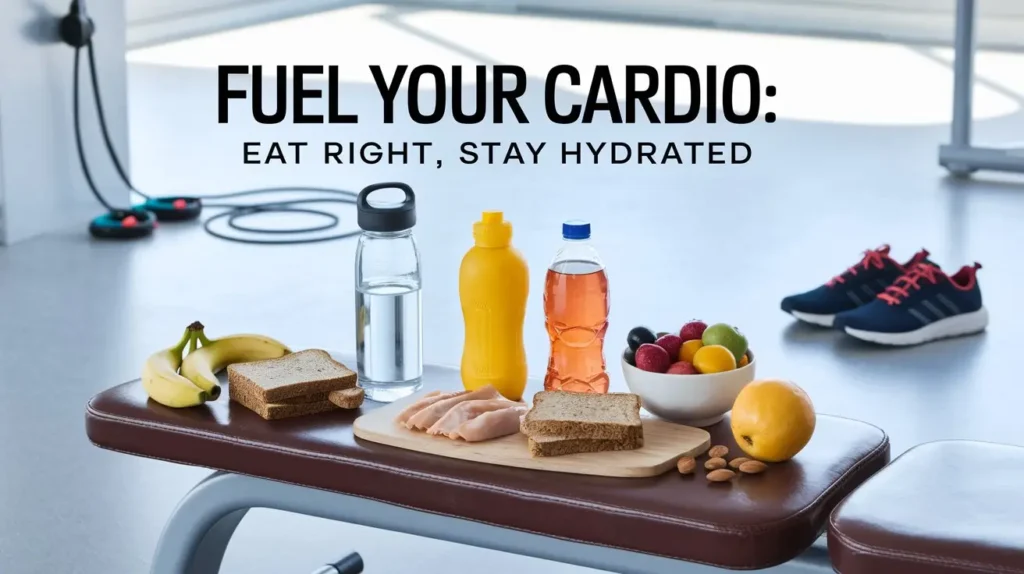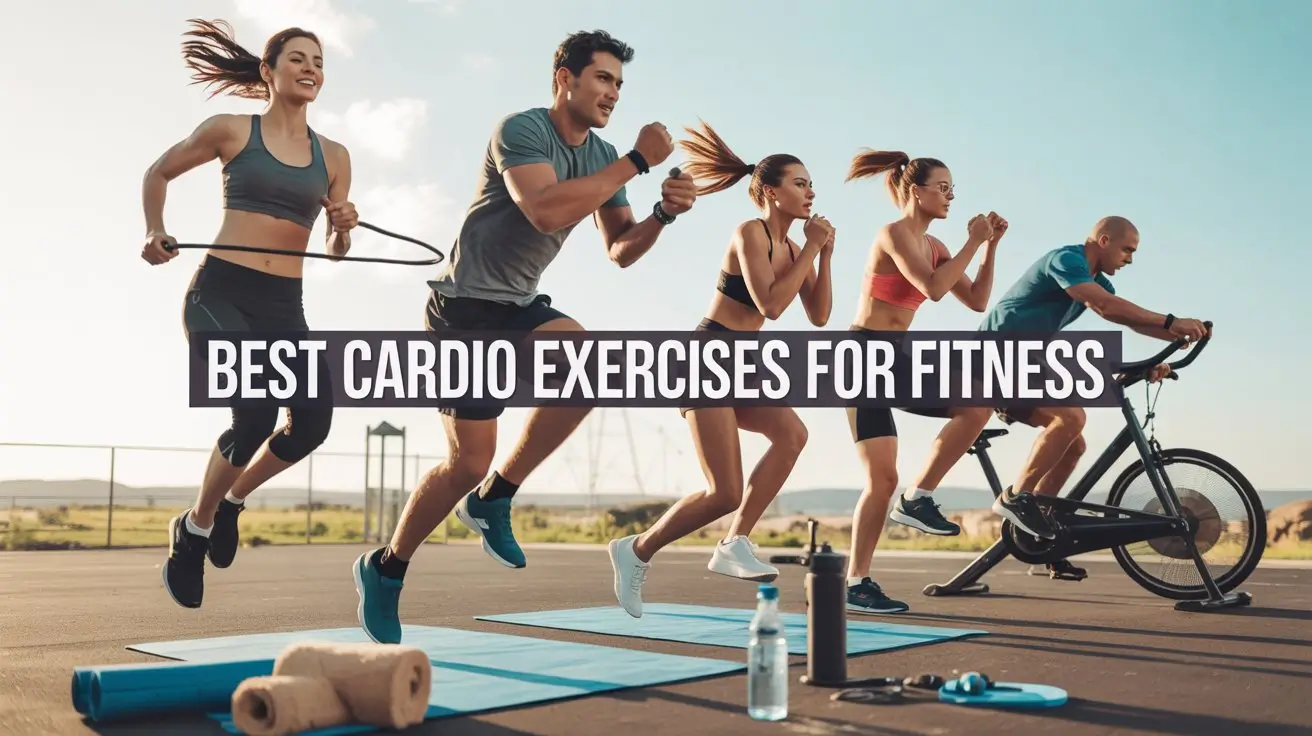Cardio exercises for fitness have always been a love-hate relationship for me. I’ll never forget my first run on a treadmill. It felt like my legs would give out after only five minutes.
I wondered how some people could run for miles without breaking a sweat! I learned that cardio isn’t about endurance. It’s also about consistency and finding a rhythm that suits you.
Cardio is a great way to improve your health. Whether you’re new to fitness or trying to get better, it can help you.
Cardio exercises are great for your heart, lungs, and weight. Studies show they help with all three. It’s a proven way to increase energy and feel more energized throughout the day. For me, the key is to mix things up. I enjoy activities like cycling, jumping rope, and quick home workouts.
In this article, I’ll share cardio exercises from fitness experts. They’re great for improving your fitness and well-being, no matter where you start. Let’s dive in.
How Cardio Exercise Boosts Your Fitness Journey
Regular cardio exercises are key to a healthy life. Running, cycling, and swimming are great for your heart. They help improve heart health and reduce the risk of heart disease. Experts suggest getting at least 150 minutes of moderate exercise. You can also do 75 minutes of vigorous activity each week.
Adding heart-healthy workouts to your day can be easy. Try a 30-minute walk or jog each day. This can help you meet the recommended cardio exercise goals.
Cardio exercises offer many benefits. They improve heart health, increase energy, and enhance mental well-being. They help with weight management. They also improve sleep and reduce the risk of diseases like diabetes and cancer.
To maximize your cardio workouts, choose activities you enjoy. Make sure they fit your lifestyle, too.
-
Brisk walking.
-
Jogging or running.
-
Swimming.
-
Cycling.
-
High-intensity interval training (HIIT).
If you have health issues, see a healthcare professional before beginning new exercises. With regular cardio and a healthy diet, you can boost your health and lower disease risks.
Getting Started with Cardio Training
Starting a cardio routine is easier when you pick an exercise you like. Regular cardio helps prevent and manage diabetes and metabolic syndrome. It also burns calories and keeps your heart and lungs healthy.
Begin with three exercise days a week, with a rest day in between. This balance is key to success.
Jumping jacks, cycling, or swimming are great for beginners. Each workout should start with a 5–10 minute warm-up to get your heart rate up. Aim for a 5 or 6 effort level on the Perceived Exertion Scale.
Try the ‘talk test’ to see how hard you’re working during exercise. If you can talk easily, you can do more.
As you get better, increase your workout time to 30 minutes. Every 4–6 weeks, add another exercise day or make your workouts harder. Keep an eye on your heart rate to stay in the target heart rate zone.
With regular effort and patience, you can build a lasting cardio routine. This will boost your health and fitness.
High-Intensity Interval Training (HIIT) Fundamentals
HIIT cardio is a top choice for improving heart health and burning calories. It mixes short, intense exercises with brief breaks. For instance, sprint for 30 seconds, then walk for 30 seconds to catch your breath. This pattern can last 15 to 20 minutes, making it quick and effective.
HIIT is great because it fits all fitness levels. Beginners can start with shorter, easier intervals. As you get better, you can do more and harder exercises. Plus, you don’t need much gear, which saves money. HIIT helps with weight loss, muscle gain, and metabolism. It’s a great choice for workouts.
-
Sprint intervals: sprint for 30 seconds, then walk for 30 seconds.
-
Burpees: do 10 burpees in a row, then rest for 30 seconds.
-
Jumping rope: jump rope for 30 seconds, then rest for 30 seconds.
Always listen to your body and adjust your HIIT workouts as needed. Make sure to warm up before and cool down afterward to avoid injuries.
Low-Impact Cardio Options for Joint Health
Low-impact cardio exercises are great for joint health. They are easy on the joints but challenging enough to keep you fit. Swimming and cycling are perfect examples of these exercises.
These workouts lower the risk of injury and improve joint mobility. Swimming, for instance, uses water to support your body, reducing joint stress. Walking is also good for your knees, as it’s easier on them than running or jogging.
Other options include rowing, indoor cycling, and using an elliptical machine. These exercises work your whole body without putting too much strain on your joints. You can also try skating, shadowboxing, or yoga, which you can make low-impact. Adding these to your routine can boost your health and fitness.
Here are some low-impact cardio exercises you can do at home or in a gym:
-
Swimming
-
Cycling
-
Rowing
-
Using an elliptical machine
-
Walking on softer surfaces
You can change these exercises to match your fitness level. They’re perfect for those wanting to improve joint health while staying active.
Advanced Cardio Training Techniques
As you get better at your cardio routine for weight loss, it’s key to add advanced techniques. These methods can help your heart, burn extra calories, and boost your performance. Research shows that advanced cardio workouts are excellent for your heart. They also help burn calories.
A solid cardio plan mixes exercises. It should work various muscles and energy systems. Try high-intensity interval training (HIIT). You can also do agility drills and strength exercises. These activities will raise your heart rate. These can make your heart stronger and improve endurance.
To level up your cardio, think about adding progressive overload and cross-training. Progressive overload means making your workouts harder over time. Cross-training mixes different exercises to boost fitness and prevent injuries.
Benefits of Progressive Overload
-
Improved cardiovascular fitness
-
Increased muscular endurance
-
Enhanced caloric burn
Examples of Cross-Training Methods
-
Combining cardio exercises with strength training.
-
Incorporating agility drills and plyometric exercises is important.
-
Including high-intensity interval training (HIIT) in your routine can boost your results.
Equipment-Free Cardio Workouts
You don’t need equipment for a great cardio workout. You can do aerobic exercises anywhere. The U.S. Department of Health and Human Services recommends that adults get at least 150 minutes of moderate aerobic exercise each week.
Jumping jacks, burpees, and mountain climbers are examples of equipment-free cardio workouts. You can do them at home or in a park. HIIT is effective and saves time when compared to steady-state cardio.
-
Jumping jacks: 30-60 seconds; rest for 30-60 seconds.
-
Burpees: 20-30 seconds, rest for 30-60 seconds.
-
Mountain climbers: 30-60 seconds; rest for 30-60 seconds.
Outdoor training is another great option for cardio without equipment. Running, cycling, and swimming are excellent aerobic workouts for the outdoors. Listen to your body, and begin your cardio exercises at a gentle pace if you’re new to them.
Nutrition and Hydration for Optimal Cardio Performance

When you do cardio exercises like running or cycling, it’s key to eat the right foods. This helps your body perform better. Eating well and drinking enough water keep you hydrated. It also ensures the correct function of your muscles.
A diet full of complex carbs, lean proteins, and healthy fats boosts your heart health. It also helps you last longer during workouts. Drinking plenty of water is also key. Dehydration can cause headaches, muscle cramps, and even heat stroke.
To stay hydrated, drink 6 to 12 ounces of water every 20 minutes while working out. Sports drinks with 6% to 8% carbs can also help. After exercising, drink 16 to 24 ounces of water or a sports drink to recover.
-
Drink 24 ounces of sports drink or electrolyte water two hours before working out.
-
Eat a meal with carbs, protein, and fats within 2 to 3 hours after working out.
-
Stay away from sugary drinks and foods that can hurt your hydration and performance.
Add cardio exercises to your routine, and you’ll boost your health and fitness. Always focus on nutrition and hydration. They help you get the best results from your workouts.
Common Mistakes to Avoid in Cardio Training
When you do endurance exercises like HIIT cardio, knowing common mistakes is key. These mistakes can slow your progress and increase injury risk. It’s vital to use the right form and technique to avoid injuries and boost your heart health.
Many beginners start too hard, aiming for “Zone 3” heart rates. This can lead to injuries and burnout. Instead, start in “Zone 2,” where heart rates are 60% to 70% of the most. This builds a strong aerobic base.
Also, make sure to include at least one rest day a week. This lets muscles repair and get stronger. Changing your workout routine helps keep you motivated. It also prevents boredom, which can slow your progress.
Some common mistakes to avoid include:
-
Neglecting strength training, which can hinder fitness.
-
Skipping recovery days, which can stall progress.
-
Focusing solely on calorie burn can lead to frustration and burnout.
By knowing these mistakes and avoiding them, you can craft a solid workout plan. This plan should include endurance exercises like HIIT cardio. Pay attention to your body and take breaks when necessary. And don’t hesitate to change your routine to keep things interesting and motivating.
Conclusion: Making Cardio a Sustainable Part of Your Fitness Journey
Starting your fitness journey? Adding regular cardio exercises is key. It helps you reach your goals and stay healthy. Whether you want to burn fat or boost your cardio routine for weight loss, cardio is essential.
Cardio has many benefits. It boosts endurance and heart health and burns calories. Find an activity you love, like walking, swimming, or interval training. This way, you’ll enjoy your cardio routine more.
Begin with a pace you’re comfortable with. Then, slowly make your workouts harder and longer. Setting goals, tracking your progress, and celebrating wins keep you motivated.
Cardio is powerful. Make it a big part of your wellness journey. With hard work and regular effort, you’ll see better heart health, more energy, and a healthier you.
FAQ
What makes cardio exercises essential for health?
Cardio exercises boost heart health, increase stamina, and help manage weight. They also uplift mood and mental health.
How do I get started with a cardio routine?
Start by choosing an exercise you like. Start at a low intensity and extend the duration while increasing the intensity. Set realistic goals and listen to your body to avoid burnout.
What are the benefits of HIIT workouts?
HIIT workouts improve heart health, burn fat, and build muscle endurance. These exercises suit all fitness levels, and you can do them at home or in a gym.
What are some low-impact cardio options for joint health?
Swimming, cycling, and using an elliptical are low-impact. They help keep joints healthy by reducing injury risk and improving mobility.
How can I make my cardio workouts more effective?
To boost your workouts, try progressive overload, cross-training, and tracking your progress. This keeps you challenged and improves your fitness.
What are some equipment-free cardio workout options?
Jumping jacks and outdoor activities like running and cycling are great. They’re easy to do and don’t cost much.
How important are nutrition and hydration for optimal cardiovascular performance?
Good nutrition and hydration are key for top cardio performance. A balanced diet and staying hydrated boost fitness and health.
What common mistakes should I avoid in cardio training?
Stay clear of form and technique mistakes. Don’t train too often, and always listen to your body. Proper form, rest, and recovery are vital for safety and success.
